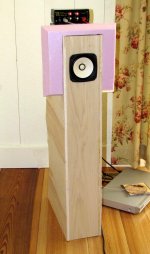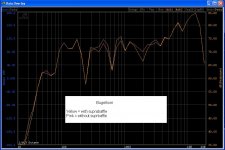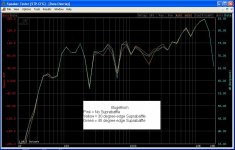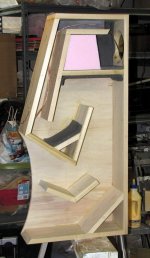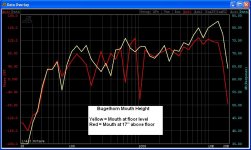Dhenryp
I have been following your project and want to say great job
Are you going to used these in a corner and eventually use a wave guide like Ron's 166 ?
Ed
I have been following your project and want to say great job

Are you going to used these in a corner and eventually use a wave guide like Ron's 166 ?
Ed
Thanks! I was beginning to wonder if anyone was watching.
I'm not sure about the corner yet - I don't have two good corners without some major rearranging. I'm also not sure about waveguides or suprabaffles. They look better without. I'll have to see here this thread takes me.
Denis
I'm not sure about the corner yet - I don't have two good corners without some major rearranging. I'm also not sure about waveguides or suprabaffles. They look better without. I'll have to see here this thread takes me.
Denis
Suprabaffle Testing
I've done some initial testing with and without a Styrofoam suprabaffle. It is ~11.5 X 11.5 inches. This time the speaker is about one foot from back wall and two feet from side wall. I've also put a little polyester stuffing about halfway in the horn path. This gives me flatter response but still plenty of base.
The difference with and without the baffle is fairly subtle. I think I like it better with but I'm not sure it's worth the lower WAF.
I've done some initial testing with and without a Styrofoam suprabaffle. It is ~11.5 X 11.5 inches. This time the speaker is about one foot from back wall and two feet from side wall. I've also put a little polyester stuffing about halfway in the horn path. This gives me flatter response but still plenty of base.
The difference with and without the baffle is fairly subtle. I think I like it better with but I'm not sure it's worth the lower WAF.
Attachments
I'm getting better with the tools. On this graph I show with and without the suprabaffle. The baffle increases output mostly a db or two but with one dip of ~ 3db at 2k. I think the dip may be due diffraction off the edge of the suprabaffle since 2Khz = wavelength of 6" = spacing from center of speaker to suprabaffle edge. I may try playing around with other shapes/sizes.
Attachments
dhenryp said:Thanks! I was beginning to wonder if anyone was watching.
I'm not sure about the corner yet - I don't have two good corners without some major rearranging.
Denis
Send em to Texas and I'll try them in corners for you 😀
Ed
Here is the second speaker ready to have the mouth painted. You can see that I've added a "V" shaped support in the mouth. I could feel the sides vibrating there while the top half of the speaker had very little. I'm planning to add .5 or .75" of MDF on the sides but I decided to add the support anyway while I have the speaker open. I'll post updated plans later.
I've cut back the foam block in the CC a couple of inches. I've broken the piece I cut out into little pieces and am adding them back in to tune the volume. Right now I'm at about 1.8 liter and will probably stay there. I've also added .5 inch adhesive back foam (grey in the picture) to a couple of bends and to the bottom and one wall of the CC
I've cut back the foam block in the CC a couple of inches. I've broken the piece I cut out into little pieces and am adding them back in to tune the volume. Right now I'm at about 1.8 liter and will probably stay there. I've also added .5 inch adhesive back foam (grey in the picture) to a couple of bends and to the bottom and one wall of the CC
Attachments
Great job, I've really enjoyed following this thread. It's nice to see someone having the courage to post measurements of their horn design, it's not something that we see often. The large hump in response ~ 180 Hz may in part be due to a room node, or the CC may be a bit too small letting midrange energy out into the horn section. You also might want to consider experimenting with a baffle step filter to tame that rising response. You'll be able to shape your response very effectively and have high WAF without a humongeous baffle. Once again great job and keep up the good work.
Thanks for the encouragement. I've been able to tame the base bump by moving the speaker out of the corner and I have also increased the CC a bit. I will look into filters. If not for the baffle step (I'm thinking on going with a removable suprabaffle) then perhaps for the rising high end of the driver.
dhenryp said:
I made an assumption a few posts back that having the mouth 14" above the floor wouldn't make a practical difference. Is my assumption correct or is there a significant benefit to be had by moving the mouth to the floor? I'll define "significant" as greater than one db and/or more than couple of hertz.
My logic is that hornresp must be assuming the mouth is literally at the corner of the room when you select corner loading and this is a good assumption because the wavelengths involved are on the order of ten feet and the actual distance from the corner is a fraction of that. Raising the mouth 14" only moves it a handful of inches further from the corner compared to a mouth exiting at the floor.
Thanks,
Denis
The above is from post 37 regarding a previous design. I'm now in the position to answer my own question. Since I'm all set up to take measurements I've plotted to responses; 1) with the mouth of the current bugelhorn on the floor and 2) with the horn elevated 17" on a handy bench. In both cases the horn is 18" from the back wall and 24" from the side wall. The mic position wasn't changed.; at driver height when the speaker is on floor and about 2 meters from speaker.
FWIW: The answer for 17" is about 3db, using ~the values at 120hz as convenient corresponding peaks. Ignore the differences at the upper frequencies as I believe these are a function of the mic height relative to the driver.
Attachments
dhenryp said:Ignore the differences at the upper frequencies as I believe these are a function of the mic height relative to the driver.
They could be, or they could be reflections inside the horn due to the mouth now being "smaller"
dave
Perhaps I'm a bit daft not being any sort of expert but merely interested in the this thread, I would have thought that the mouth would be 17" larger since it was that much further up the wall, so to speak 🙂
I didn't think SM styro was an "absorbtive" medium, being it is closed-cell. I'm not sure if it is doing anything other than filling space inside the enclosure.
I'm prepared to be corrected, I just never seen is used as fill before.
(a good material to test baffle shapes of course)
I'm prepared to be corrected, I just never seen is used as fill before.
(a good material to test baffle shapes of course)
planet10 said:
They could be, or they could be reflections inside the horn due to the mouth now being "smaller"
dave
You might be right but I'm not sure I understand how that much of the 10K+ frequencies could be making its way out of the horn.
I've also added .5 inch adhesive back foam (grey in the picture) to a couple of bends and to the bottom and one wall of the CC
Looking Good!
A suggestion if I may. Do not add any damping material that you cannot easily remove😉
Horns can be very sensitive, sometimes a little damping in the wrong place kills them.
jemraid said:Perhaps I'm a bit daft not being any sort of expert but merely interested in the this thread, I would have thought that the mouth would be 17" larger since it was that much further up the wall, so to speak 🙂
The floor acts as a mirror (as does the corner)... at the floor in the corner you magnify the apparent mouth size by 8x, lift it up it becomes 4x.
dave
ruerose said:I didn't think SM styro was an "absorbtive" medium, being it is closed-cell. I'm not sure if it is doing anything other than filling space inside the enclosure.
I'm prepared to be corrected, I just never seen is used as fill before.
(a good material to test baffle shapes of course)
I'm only using it to take up space in the CC so I'm depending on it to not absorb anything. If it did absorb, I think it would tend to increase the effective CC size (as fiberglass insulation would).
Jem - The closer the mouth is to the fllor/wall boundary the better it reinforces the low frequencies.
dhenryp said:
You might be right but I'm not sure I understand how that much of the 10K+ frequencies could be making its way out of the horn.
I'm referring to the ripples at circa 200, 350, 600, 1000 Hz.
dave
Andrewbee said:
Looking Good!
A suggestion if I may. Do not add any damping material that you cannot easily remove😉
Horns can be very sensitive, sometimes a little damping in the wrong place kills them.
Thanks. I can get to all but one of the bends from the outside. Maybe I'll remove it before I seal it up.
- Status
- Not open for further replies.
- Home
- Loudspeakers
- Full Range
- Bigger Frugel horn (Bugelhorn?)
